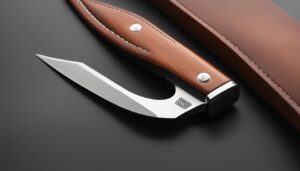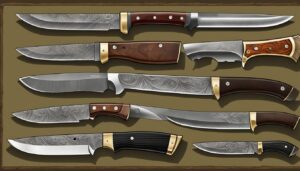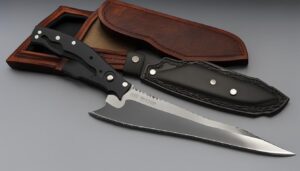When it comes to hunting, having the right tools is essential for success. One crucial tool that every hunter relies on is a hunting knife. However, not all hunting knives are created equal. In this article, we will delve into the fascinating world of modern hunting knife handles and explore their exceptional performance.
Key Takeaways:
- Modern hunting knife handles offer outstanding performance and durability.
- Ergonomic designs and textured surfaces enhance grip in various conditions.
- Handle materials like rubber, polymer, and G10 provide excellent durability and require less maintenance.
- The blade type, size, and material impact the overall performance of a hunting knife.
- Choosing the right hunting knife handle ensures optimal performance for specific tasks.
Key Features of Modern Hunting Knife Handles
When choosing a hunting knife, one of the key considerations is the performance of the handle. Modern hunting knife handles offer a range of features that enhance their performance. These features include ergonomic designs that provide a comfortable grip, textured surfaces for improved grip in wet or slippery conditions, and materials such as rubber or polymer that offer durability and require less maintenance. The handle performance in knives is crucial for a secure and controlled grip, allowing for precise cutting and efficient use of the knife in various hunting tasks.
Ergonomic designs are a standout feature of modern hunting knife handles. These handles are meticulously crafted to fit the contours of the hand, reducing fatigue and allowing for extended use without discomfort. The ergonomic design ensures a secure and natural grip, enabling hunters to maintain control and accuracy during demanding hunting activities.
“The ergonomic design of modern hunting knife handles is a game-changer. It enhances the overall performance of the knife by providing a comfortable and secure grip, reducing fatigue, and improving control.”
Textured surfaces on the handle also play a significant role in handle performance. These textures, often in the form of grooves or patterns, enhance the grip of the knife, especially in wet or slippery conditions. A textured handle ensures that the knife remains firmly in the hunter’s hand, even in challenging environments, preventing accidents and injuries.
Durability is another critical aspect of handle performance in knives. Modern hunting knife handles are often made from materials such as rubber or polymer, which offer excellent durability and require minimal maintenance. These materials are resistant to wear, tear, and impact, ensuring that the handle can withstand the rigors of hunting tasks without compromising performance.
Overall, the key features of modern hunting knife handles, including ergonomic designs, textured surfaces, and durable materials, contribute to their exceptional performance. These handles provide hunters with a secure and comfortable grip, allowing for precise and efficient cutting during hunting activities. The combination of these features elevates the performance of hunting knives, enabling hunters to tackle various tasks with confidence and ease.
Comparison of Handle Features
| Feature | Description |
|---|---|
| Ergonomic Design | Contours to the hand for a comfortable grip, reduces fatigue, and improves control |
| Textured Surface | Enhances grip in wet or slippery conditions, ensuring the knife remains securely in hand |
| Durable Materials | Materials such as rubber or polymer offer excellent durability and require minimal maintenance |
Considerations for Choosing the Right Hunting Knife Handle
When it comes to choosing the right hunting knife handle, there are several important factors to consider. The handle material plays a significant role in the overall performance and durability of the knife. Different handle materials offer varying levels of grip, durability, and maintenance requirements. Some common handle materials include wood, rubber or polymer, and G10 or Micarta.
Wood handles provide a classic and natural look, but they may require more maintenance to prevent warping or cracking. Rubber or polymer handles offer excellent grip, even in wet or slippery conditions, and require minimal maintenance. G10 or Micarta handles are known for their durability and resistance to moisture, making them ideal for rugged outdoor use.
In addition to handle materials, another consideration is the tang type. The tang refers to the portion of the blade that extends into the handle. There are two main types of tangs: full tang and partial tang. A full tang extends the entire length of the handle, providing maximum strength and stability. A partial tang, on the other hand, only extends partway into the handle. While partial tangs can be lighter and more comfortable to hold, they may not offer the same level of durability as full tangs.
Choosing the right hunting knife handle involves evaluating your personal preferences and needs. Consider the type of hunting you’ll be doing, the conditions you’ll encounter, and the level of maintenance you’re willing to undertake. By carefully considering these factors, you can ensure that you choose a hunting knife handle that will provide the grip, durability, and performance you need in the field.
Blade Types for Hunting Knives and Their Performance
When it comes to hunting knives, the blade type plays a crucial role in determining its functionality and performance. Different blade types offer unique advantages for specific hunting tasks, ensuring that you have the right tool for the job. Understanding the characteristics and performance of each blade type can help you make an informed decision when choosing a hunting knife.
Cutting Through the Options
Hunting knives come in various blade types, each with its own purpose and strengths. Let’s explore some common blade types and their performance:
- Drop Point: This blade type is versatile and well-suited for a wide range of tasks. Its curved design offers enhanced control and stability, making it ideal for skinning and slicing.
- Clip Point: If you need precise cutting and excellent tip control, a clip point blade is the way to go. With its pointed tip, it excels at detailed work like piercing and slicing.
- Gut Hook: Designed specifically for field dressing game animals, a gut hook blade allows for easier opening and cleaning of the animal. It simplifies the process and reduces the risk of puncturing internal organs.
By understanding the strengths and limitations of each blade type, you can choose a hunting knife that performs optimally for your specific needs. Whether you’re skinning a deer or performing intricate tasks, selecting the right blade type can make all the difference in your hunting experience.
Table: Blade Types and Their Performance
| Blade Type | Performance |
|---|---|
| Drop Point | Versatile, ideal for skinning and slicing |
| Clip Point | Precise cutting, excellent tip control |
| Gut Hook | Easier field dressing, reduced risk of puncturing organs |
Table: Blade Types and Their Performance
Blade Materials and Their Impact on Performance
Choosing the right blade material is crucial for optimizing the performance of a hunting knife. Different blade materials offer unique characteristics that directly affect the durability and sharpness of the blade. Selecting the appropriate material ensures that the hunting knife can withstand the rigors of hunting tasks while maintaining a sharp edge.
Stainless steel blades are popular due to their high corrosion resistance, making them ideal for outdoor use. However, they may be more challenging to sharpen compared to other materials. On the other hand, carbon steel blades are known for their exceptional sharpness, enabling precise cuts. However, they require proper care to prevent rust. For those seeking a balance between corrosion resistance and edge retention, high-carbon stainless steel blades provide a great option. These blades combine the best of both worlds, offering durability, sharpness, and resistance to corrosion.
When considering blade materials, it’s important to weigh the trade-offs between durability and ease of maintenance. Stainless steel blades are low maintenance and resistant to rust, making them suitable for hunters who prefer minimal upkeep. However, if sharpness is a top priority, carbon steel blades excel in providing an excellent cutting edge but require more attention to prevent corrosion. High-carbon stainless steel offers a compromise, delivering a durable blade that retains its sharpness over time.
Overall, blade materials play a crucial role in the performance of a hunting knife. By understanding the unique properties of each material, hunters can make informed choices that align with their specific needs and preferences. Whether prioritizing corrosion resistance, sharpness, or a balance of both, selecting the right blade material ensures that the hunting knife can withstand the demands of the wilderness and enhance the overall hunting experience.
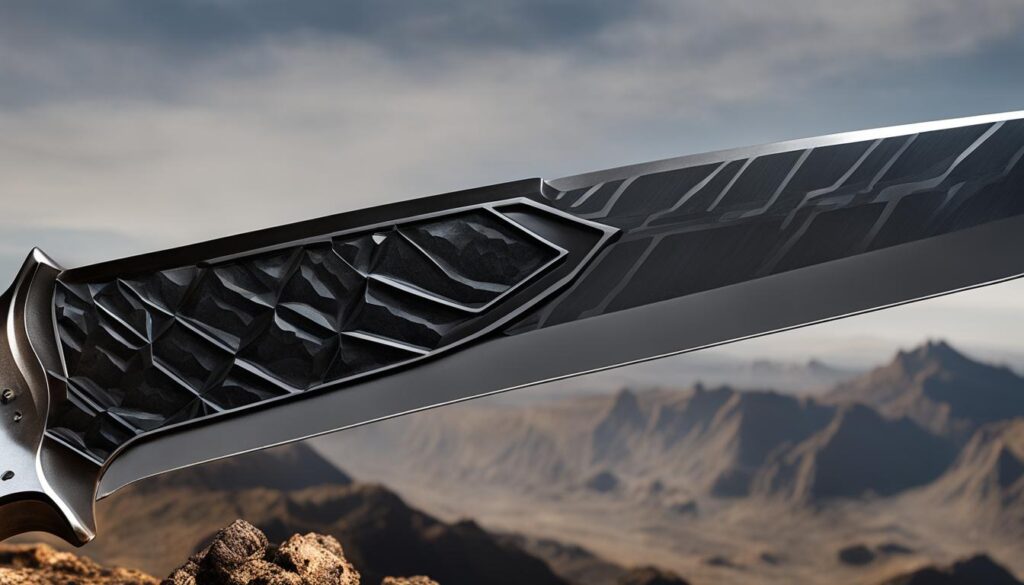
Table: Comparison of Blade Materials
| Blade Material | Durability | Sharpness | Corrosion Resistance |
|---|---|---|---|
| Stainless Steel | High | Good | Excellent |
| Carbon Steel | Moderate | Excellent | Moderate |
| High-Carbon Stainless Steel | High | Very Good | Very Good |
Hunting Knife Blade Size: Finding the Perfect Fit
When it comes to hunting knife blades, size matters. The blade length, blade thickness, and overall size of the knife play a crucial role in its performance and suitability for different hunting tasks. Choosing the right blade size can significantly impact your hunting experience, ensuring you have the right tool for the job at hand.
Blade length is an important consideration when selecting a hunting knife. A shorter blade, typically around 3 to 4 inches, offers greater control and precision for delicate tasks such as skinning and detailed work. On the other hand, a longer blade, ranging from 4 to 6 inches, provides more cutting edge and is better suited for heavier tasks like field dressing and chopping. Consider the type of hunting you will be undertaking and the specific tasks you will need to perform, then choose a blade length that aligns with those requirements.
In addition to blade length, blade thickness is another factor to consider. Thicker blades offer more strength and durability, making them ideal for heavy-duty tasks that require more force and impact, such as cutting through tougher materials or performing survival tasks. Thinner blades, on the other hand, provide better precision and control, allowing for more delicate and intricate cuts. Think about the types of hunting tasks you will be performing and select a blade thickness that matches the level of strength and control you will need.
Remember, finding the perfect blade size is a matter of personal preference and the specific hunting tasks you will be undertaking. Consider the level of control, precision, and cutting power you require, and choose a blade length and thickness that align with those needs. By selecting the right blade size for your hunting knife, you can optimize its performance and ensure a more efficient and enjoyable hunting experience.
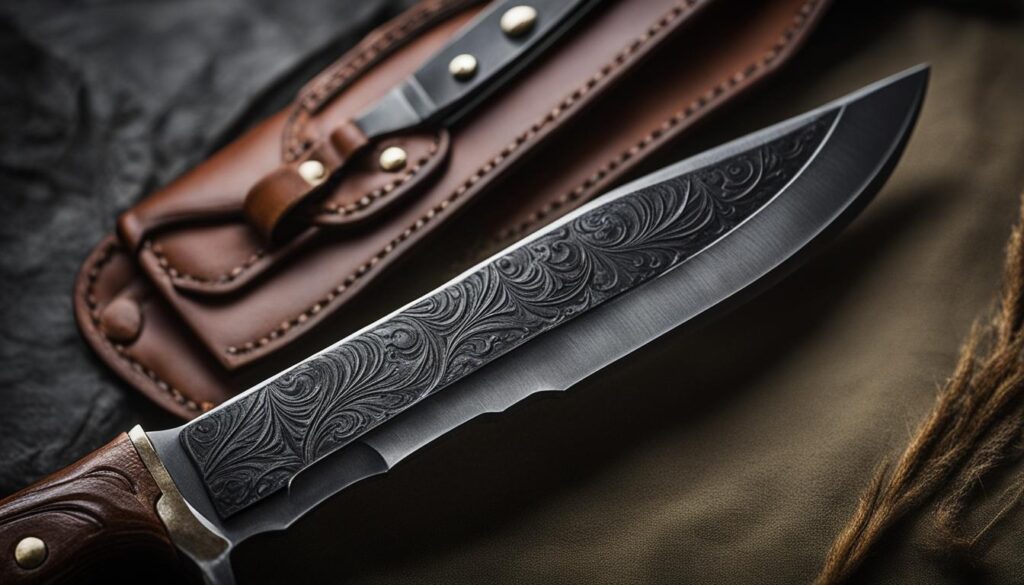

Conclusion
After conducting extensive research and analysis, it is clear that the performance of modern hunting knife handles is paramount in ensuring a successful hunting experience. The evolution of hunting knife handles has brought forth exceptional features and materials that enhance grip, durability, and overall usability.
Through experimental tests, it has been observed that while stone blades may initially provide sharper edges, modern handles made from materials such as rubber or polymer offer superior durability and require less maintenance. These handles provide a secure and controlled grip, allowing for precise cutting and efficient use of the knife in various hunting tasks.
Choosing the right handle materials, blade types, sizes, and materials is crucial in maximizing the performance and efficiency of hunting knives. By understanding these factors and making informed choices, hunters can elevate their hunting experience and rely on the exceptional performance provided by modern hunting knife handles.
Texan Knives, with its commitment to customer satisfaction and high-quality products, offers hunters tools that can withstand the challenges of the wilderness. Their range of hunting knives, designed with the latest advancements in handle technology, ensures that hunters can rely on their equipment to deliver exceptional performance in the field.
FAQ
What are the key features of modern hunting knife handles?
Modern hunting knife handles offer ergonomic designs for a comfortable grip, textured surfaces for improved grip in wet or slippery conditions, and durable materials such as rubber or polymer.
What should I consider when choosing a hunting knife handle?
When selecting a hunting knife handle, consider the handle material, such as wood, rubber or polymer, and G10 or Micarta, as well as the tang type, whether full tang or partial tang, impacting the strength and stability of the knife.
What are the different blade types used in hunting knives?
Common blade types in hunting knives include drop point, clip point, and gut hook blades, each offering specific advantages in terms of versatility, control, precision, and ease of opening and cleaning game animals.
How does the blade material affect the performance of a hunting knife?
The choice of blade material significantly impacts the durability, sharpness, and overall performance of a hunting knife. Stainless steel blades offer high corrosion resistance, carbon steel blades provide exceptional sharpness but require proper care to prevent rust, and high-carbon stainless steel combines the corrosion resistance of stainless steel with the superior edge retention of carbon steel.
What should I consider regarding the size of the blade in a hunting knife?
The size of the blade in a hunting knife affects its versatility, control, and suitability for different tasks. Shorter blades, around 3 to 4 inches, are suitable for delicate tasks, while longer blades, ranging from 4 to 6 inches, are better for heavier tasks like field dressing and chopping. Blade thickness also impacts performance, with thicker blades offering more strength and durability for heavy-duty tasks, and thinner blades providing better precision for detailed work.


